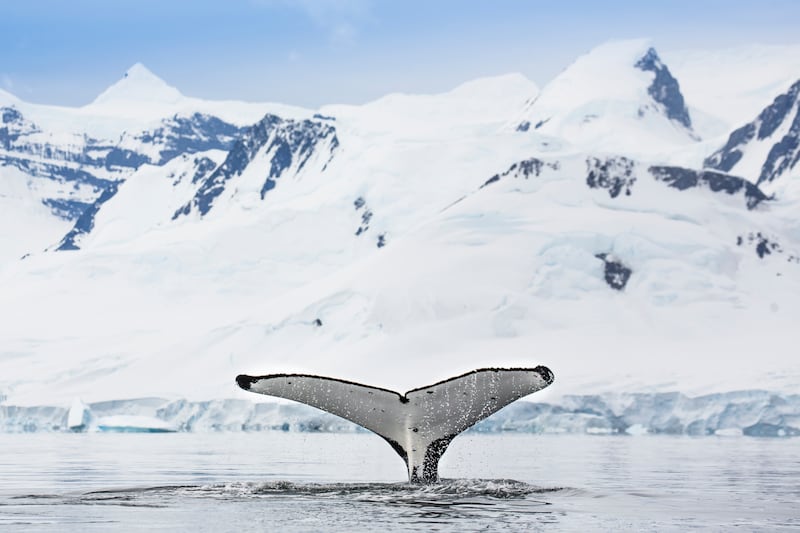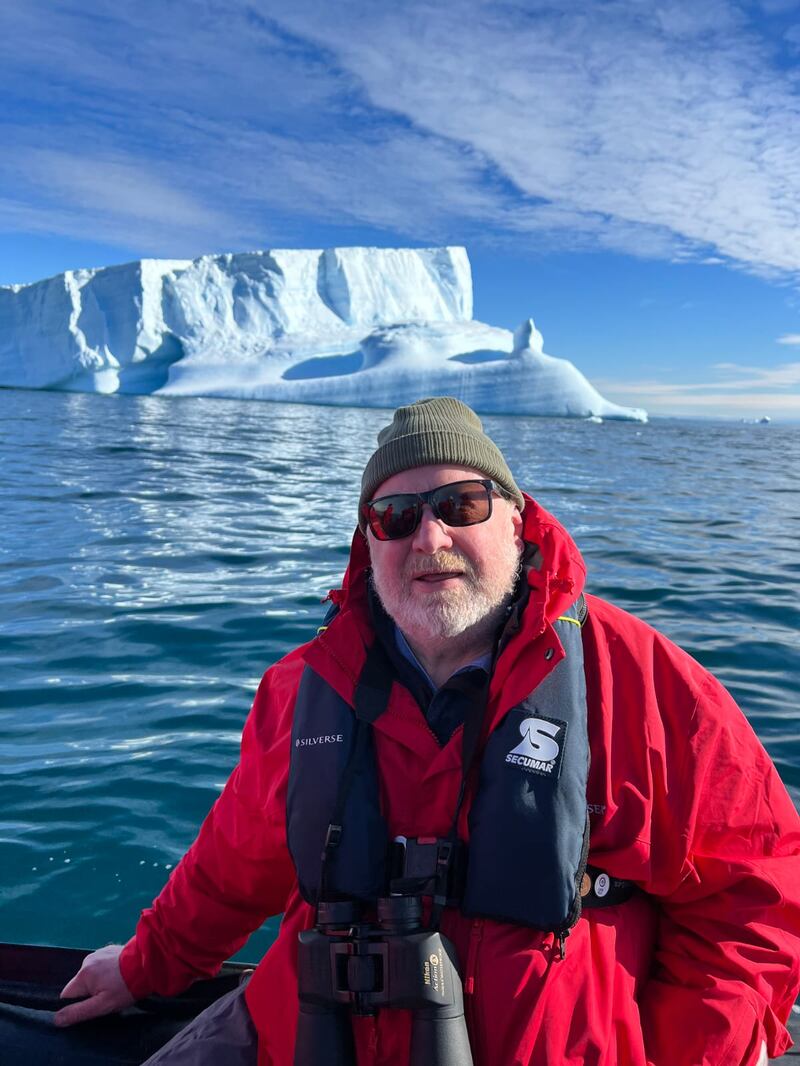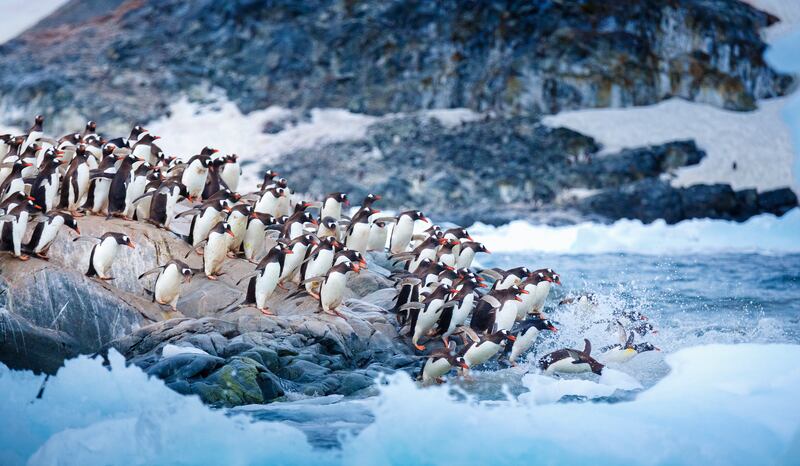I can only contemplate the vastness of the Southern Ocean, in all its cold majesty, with awe; the rolling white-tipped waves overlaid, it seems, by the most delicate of lace strands, the sheets of tinted-glass-like broken sea ice, the stately procession of towering flat-topped icebergs and, speeding past, smaller cousins in all shapes and sizes. It is a spiritual experience.
This is Antarctic midsummer, in glorious but frosty sunshine, and I am watching out for whales or albatross or “just” penguins from the balcony of the cruise ship Silver Wind. One thousand nautical miles from southern Chile to the Antarctic Peninsula, the finger-like extension to the continental land mass which points up to Tierra del Fuego, we’re on a two-week expedition, as our hosts would describe it, but with all the creature comforts and luxury of a cruise.
We have seen whales – their spouts and breaches, their mournful wails – in abundance, most memorably when two humpbacks and their baby headed straight for our Zodiac dinghy, diving within metres of our bow and re-emerging astern, close enough to touch.
Later I sit in the ship gym pedalling away, watching this strange iceberg procession pass us by, modern art structures on the march (to the sound of Bruce Springsteen) against a backdrop of great floating walls of ice. Two humpbacks surface a few hundred metres away, breaching and diving with great fluke displays. It’s beautifully surreal.
READ MORE
We have climbed the hills on the Falkland Islands to look down on the world’s largest rookery of black-browed albatross, a nesting site they share amicably with the diminutive rockhopper penguins whose clumsy young tumble comically between the nests of their giant neighbours. We have walked through deep snow between vast adélie and gentoo penguin colonies, watching them carefully protect eggs from marauding skuas, as thieving members of their own community steal stones from nests and fisticuffs break out between rival males.
We navigate across “penguin highways”, waiting on the determined waddling dinner-jacketed waiters to pass, careful at all times to give them the right of way. The distinctive waddle, we are told, is actually an energy-efficient means of getting around.
The real trick is to catch them with a camera as they appear to bounce across the water, “dolphining” like skimming stones.
In the shadow of Elephant Island, where Ernest Shackleton, Tom Crean and the extraordinary navigator Frank Worsley left 22 of the Endurance crew to go on his epic journey to South Georgia for help in a small boat, we witness a “feeding aggregation”, as if it was laid on for us. Up to 100 whales and hundreds of penguins, cape petrels and other seabirds feast together on krill swarms driven up from the bottom of the sea.

The largely intact “wreck” of the Endurance was discovered last March, some 3,000m under the ice in the Weddell Sea, 300 nautical miles south of us. The account by expedition leader Mensun Bound, The Ship Beneath the Ice, is a riveting story of the search woven around Shackleton’s own adventure and my most appropriate shipboard read.
Bound, whom I meet in Port Stanley, speaks of shocking evidence all around him of the rolling ecological disaster facing the Antarctic on his return last year to the Weddell Sea. As well as melting glaciers, “I could not believe the extent to which the sea ice had not just shrunk but thinned. Three years ago we had to battle through multiyear ice but this year, just sliced through it. [It’s] like a different world.”
He warns of the particular dangers of acidification. It is killing off the phytoplankton, highly sensitive to warming temperatures from climate change and acid variations; starving the krill, the vital food source of all the higher marine mammals; and jeopardising even nature’s giant blue whales, the biggest animal on earth and exclusively a krill eater. “Just one degree wipes out whole levels of phytoplankton, also nature’s real ‘carbon scrubbers’.”
Along the western side of the peninsula, the dwindling numbers and sizes of once-vast adélie penguin rookeries are testimony to the process. Unlike their gentoo cousins, these penguins are incapable of following the food and so return futilely every year to what are becoming ghost communities.

“This part of the world is where we produce most of the heavy, cold, salty water,” Bound adds. It is vital to world weather. “It spills out of the Weddell Sea and crosses the circumpolar region into the Atlantic and the Indian Ocean, where it drives these great conveyor belts of rich, cold, heavy water, which feed all these marine communities but drive the weather.”
On south we move to the stony slopes of Paulet Island, one of the Danger Islands on the peninsula proper. The strand is like a business convention on Blackpool beach midsummer, with dinner-jacketed throngs lining every square inch of the promenade. Penguins queue patiently in single file down the side of the precipitous mountain to join the party – relatively few fall – and then waddle up to the sea’s edge to jump in somewhat inelegantly. There are so many that we can’t land without disturbing them. Well offshore, however, we can certainly smell the s**t and hear the racket.
Among the new bird sightings are cormorants, skua and the endearing “s**t chickens”, the crew’s nickname for the scavenging Snowy Sheathbills. These angelic-looking snow-white birds have a diet consisting largely of penguin poo, supplemented often by the krill they cheekily prise from the beaks of parent penguins feeding their chicks.
Wilhelmina Bay is a sheltered lough about a kilometre wide, surrounded by towering snow-capped mountains and glaciers. No better place in dazzling sunshine and blue chilly skies for a quick swim. A hundred or so of the most foolhardy passengers, half our number, take part in the “polar plunge” – minus 2 degrees. Only 30 of us opt a couple of days later for our second bracing dip.
We have been lucky, luckier than most, the crew tells us – mild weather, glorious sun and, for the most part, subdued winds have allowed multiple shore landings and Zodiac dinghy cruises to get up close to nature.
Its richness and variety is breathtaking. On Christmas Day at Port Stanley, as with every day, the day’s passenger sightings are listed on the ship notice board: king penguin, magellanic penguin, black browed albatross, southern giant petrel, southern fulmar, slender-billed prion, Antarctic shag, imperial shag, kelp gull, dolphin gull, South American tern, turkey vulture and upland goose. The whales and dolphins listed: fin whale, sei whale, hourglass dolphin and peale’s dolphin.
We see somnolent sea lions resting on the Port Stanley jetty and, later, leopard and elephant seals. This is just the start. Farther south on the peninsula there are new sightings recorded every day – gentoo penguins by the million and humpback and minke whales in profusion.
When we speak of “frozen”, we tend to think in terms of immobility or of fixedness. In this beautiful frozen wilderness of Wilhelmina Bay, however, that sense of the word could not be further from the truth.
This is an intensely dynamic environment, constantly, and sometimes dangerously, on the move; from the shifting fields of sea ice and passing icebergs – a house-sized one sped past while we were swimming – to the dramatic calving of a glacier which sent tons of ice plunging into the sea a couple of hundred metres from our Zodiacs. With a great “crack” and splash, an underwater displacement tipped a church-like block right beside us suddenly on its side.
Many turn turtle completely. There is nothing fixed about these beautiful lumps. Many bear the scars of similar upturnings, broad scratch marks from encounters with the rugged bottom of the sea or dirty grey marks on their once pristine tops from the krill deposits that lined the former undersides of the bergs, providing nourishment for many species.

Eventually, we turn north again on our way back to Chile, stopping off at Whalers Bay in the South Shetlands, an almost brutal contrast that speaks volumes about man’s malign role in these parts. The ship enters through a spectacular gateway in the steep wall of Deception Island’s giant collapsed caldera, still an active volcano. Wisps of smoke rise from parts of the sea and cover an internal lake – geothermal springs at Pendulum Cove, where the inhabitants once bathed. No more. Whaling is dead and the volcano disposed of two research bases.
The island is dark brown lava, its fine, gentle sandy beach home to massive rusting remains of a major whaling centre. It’s a strange dystopian vision: great tanks for the whale oil and diesel needed to process it, a jumble of giant tanks, pipes, tubes and metalwork that were once the pressure cookers needed to get blubber and meat from the bones, a dry dock for emergency repairs and, in the distance, offices and shelter for the small hardy band who lived here throughout the year to run the station. Once again, the hardy gentoo penguins by the thousand.
Our passage has throughout been narrated and contextualised by the ship’s team of 27 enthusiastic guides, experts and “ologists” – not ivory-tower academics but joyful expert enthusiasts, champions of their subjects, who pass on their passion. Lectures range from identifying and understanding birds, their migrations and extraordinary ability to smell out a meal at 80km, and whales (identified by comparing their unique flukes online using facial recognition software), to Shackleton’s story, to the mysteries of ocean currents, the nature of ice and even the fluid dynamics of penguin defecation.
(An aside: to maintain desired social distancing within their crowded communities, the adult penguin can projectile defecate 1.2m, with a rectal pressure of about 10 kilopascals. A previous work on the subject won the satirical Ig Nobel Prize for humorous but thought-provoking scientific discoveries.)
The ethos of the Silver Wind, as it is for all of the small international fleet that cruise these waters, is rightly all about respect for this pristine wilderness environment and its inhabitants and is rigorously enforced. Nothing left behind, nothing taken away, all clothing and boots carefully disinfected every time we leave land. Our privileged access can and must be cost-free to this endangered world.
From my balcony I follow the meandering, elegant course of an albatross, swooping over the waves, its broad wings barely moving. From those waves, a few hundred metres away, a thin black line emerges with the unmistakable small fin of the humpback. A small spouting and then a dive, his tail fluke lazily waving goodbye. And, gone.
Patrick Smyth paid his own way on Silversea’s Sliver Wind, for what he describes as a bucket-list retirement present to himself. The cruise was one of roughly 70 trips to the Antarctic this summer (our winter) from a range of international companies. Prices depend on days at sea and standard of accommodation booked – Silversea, which prides itself on a particularly luxurious and ethical product, charged €19,000 for the 14-day cruise in a room with balcony. Return travel to and from cruise departure point in southern Chile, cabin with balcony, meals and drinks, included. silversea.com














